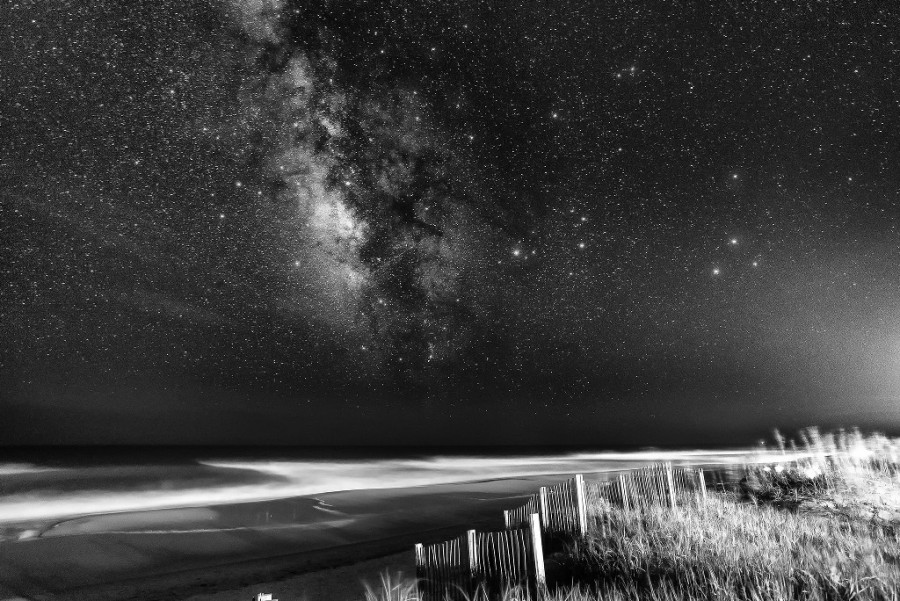
Shoreline of the Universe by Bill Dickinson. Ref: NASA APOD, 20 Sept. 2014. http://apod.nasa.gov/apod/ap140920.html
Brian Cox, 2013. Lecture on the Universe. Transcript on supernova explosions in the distant galaxies and the use of analogies to daily activities such as the baking of bread to explain the Hubble Law. How the use of analogies and metaphors in language can help in the structuring and understanding of a concept for those outside of the discipline of quantum physics.
[16:22]
now these are rare / you get one supernova per century per galaxy / so very rare / but there are a lot of galaxies / and this is a beautiful picture / i think again / from the hubble space telescope
[17:08-21:06]
a supernova in our galaxy happens once every hundred years / the most famous one happened in 1054 ad / this is a picture of it today / it’s called the crab nebula / you can see it with a small telescope in the sky / it’s a beautiful cloud of expanding gas / so this is a star that has died and exploded / 1054 ad it exploded / how do we know that / because it was observed by chinese astronomers and particularly interesting i think / and it’s one place i’d have the pleasure of visiting in one of my tv programmes is this one / it’s called chaco canyon / which is in southwestern united states / very close to the mexican border / there was a civilization here thousand years ago built structures like this / enormous castles and houses in the desert you see the ruins you tend to of uhm / well i tend to think of it in a cliched way / the native americans on the planes / riding horses and you get an impression of what they’re like from western films cowboys and indians films /actually many of these civilizations were extremely sophisticated and built these giant structures that is still there in the desert / this is in new mexico chaco canyon and these people / this is a picture of me of course / but what’s fascinating is not me / but this here because these people saw that explosion in 1054 we strongly believe and this is a painting of the explosion the supernova / and this was six thousand light years away which is a star a long way away from us / and this is a drawing of the crescent moon / this is a drawing of a new star that appeared glowing as brightly as the moon / and it’s thought that this handprint points / you see it’s over the overhang of the rock / points to a place in the sky / and with modern computer simulations / you can wind the sky back to see what it would’ve looked like uhm / this july fourth 1054 ad when the supernova happened / and you find that indeed that supernova would’ve happened next to the moon in exactly that place at that point in the sky / it would’ve glown as brightly / shone as brightly as the moon and the moon was in that shape that crescent / so it’s a beautiful piece of detective work that tells us that these people / a thousand years ago observed a new star shining brightly in the sky for two weeks / a cramped supernova explosion / so when you put all that together / what do you get / well / we’ve got lots of distant galaxies / we know how far they are away / we know how fast they are receding / what we find is something called the hubble law and it’s basically a very simple / it says that the further the galaxy is away the faster it’s flying away from us / now how are we to interpret that / i mean you might naively say well does that mean we’re somehow in the center of the universe with things flying away / well no actually / if you think a little bit more / if you think for example about baking bread / if you get a lump of dough and put raisins in it and stick it in the oven / then the bread expands so all the raisins move away from every other raisin / if you had sat on one raisin / what you would see is the hubble law / exactly the hubble law / you see the ones close to you moving away more slowly / the ones moving away / moving away quicker / because the bread is stretching / all of space is stretching at a constant rate / so you get this fascinating law which is exactly what we observe / i wanted to give you the number because it’s a very interesting number / i gave a lecture / i don’t know if any of you know the hitchiker’s guide to the galaxy / do any of you know that / douglas adams / yeah you know / brilliant / if you don’t know it you should read it / it’s a wonderful funny hilarious book / in hitchiker’s guide to the galaxy there’s a very famous number / the answer to life to the universe to everything / and it is the number 42 / it’s been famous for years / everyone knows douglas adams knows the number / it does actually turn out remarkably the hubble constnat can be written like this / 42 miles per second per 3 million light years / what does that mean / it means that for every 3 million light years you go away from the earth / […] then on average things things will be moving away 42 miles per second
—
Reference
Brian Cox. Published on Feb 24, 2013. A lecture by Brian Cox on how the universe was created. Internet resource at http://youtu.be/6u9YmpCg9bY.